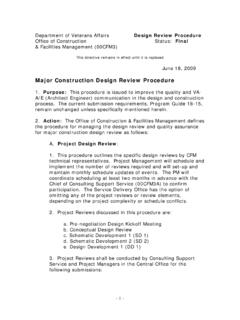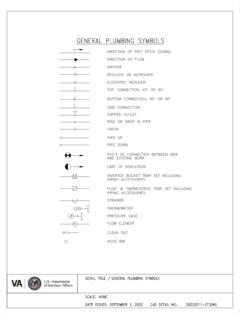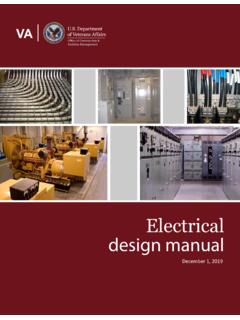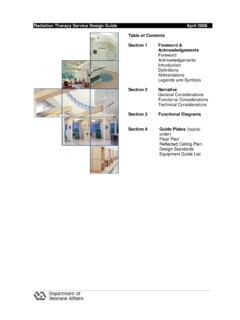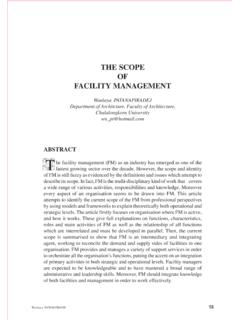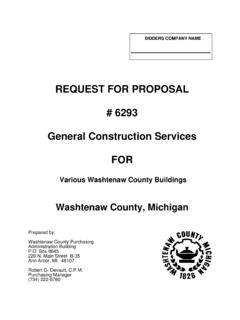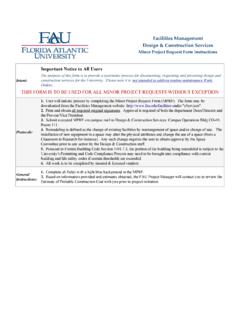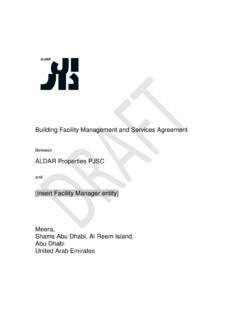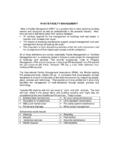Transcription of Mental Health Design Guide - United States …
1 Rev 12/01/2017 Mental Health facilities Design Guide December 2010 i Office of construction & facilities management Table of Contents INTRODUCTION Foreword 1-1 Acknowledgements 1-5 Design Guide Introduction 1-9 Definitions 1-11 Abbreviations 1-13 Legend of Symbols 1-16 GENERAL OPERATIONAL NARRATIVE Operational Summary 2-1 Guiding Principles 2-5 Operational / Planning Recommendations 2-7 General Trends in Mental Health Design Design Recommendations 2-10 Flexibility Efficiency Patient Needs Risk Reduction PLANNING AND Design CRITERIA Introduction 3-1 Inpatient Mental Health Units 3-3 Introduction Current Examples Inpatient Mental Health Unit Relationship Diagram Inpatient Entrance/Reception Patient Room Patient Bathroom Patient Activity Areas Nursing Station Design and Operations Outdoor Courtyards Accommodations for Women Veterans and Other Patient Subgroups Mental Health Residential Rehabilitation Treatment Program (MH RRTP) Facility 3-38 Introduction Overall Facility Relationship Diagram Resident Room Multiple Occupancy Living Unit Resident Activity Areas Outdoor Activity Spaces Outpatient services 3-46 Introduction Mental Health Clinic Substance Abuse Clinic Mental Health facilities Design Guide December 2010 ii Office of construction & facilities management Psychosocial Rehabilitation and Recovery Center (PRRC)
2 Psychology services Primary Care- Mental Health Integration services TECHNICAL NARRATIVE Codes and Standards 4-1 National Codes and References Other Recommended References and Standards Local Codes and References HIPAA Emergency Provisions Site Design Guidelines 4-8 Introduction Planning Topography Zoning Archeological/Historic Features Roadways Site Signage/Wayfinding Proximity to Adjoining facilities Shared Site Features Utility Access services Landscaping Inpatient Exterior Spaces Covered Entry Architecture 4-15 Introduction Exterior Architecture Patient and Staff Safety/Security Overview Interior Wall and Ceiling construction Door construction and Hardware Windows and Glazing Interior Design 4-20 Introduction Lighting Acoustics Interior Finishes Wayfinding & Signage Wall Mounted Items Patient Furnishings Structural 4-30 Equipment 4-30 Heating, Ventilation and Air Conditioning 4-31 Plumbing 4-34 Electrical 4-37 Communications 4-40 Waste management 4-42 Transportation 4-43 Mental Health facilities Design Guide December 2010 iii Office of construction & facilities management Mental Health & BEHAVIORAL CARE UNITS Reference Space Criteria Chapter 110 Patient Room, One Bed / Bathroom, Standard 5-2 Patient Room, One Bed / Bathroom, Accessible 5-10 Patient Room, One Bed / Bathroom, Bariatric 5-18 Patient Room, Two Bed / Bathroom, Standard 5-26 Seclusion Room.
3 Isolation / Seclusion / Anteroom 5-34 Nursing Station / Nurse Workroom / Medication Room / Team Room 5-39 Dining Room / Serving / Pantry 5-47 Dayroom 5-53 Group Room 5-57 Mental Health RESIDENTIAL REHABILITATION TREATMENT PROGRAM (MH RRTP) FACILITY Reference Space Criteria Chapter 312 MH RRTP Two Bedroom Suite 6-2 Bedroom, One-Bed / Bathroom, Standard 6-8 Bedroom, One-Bed, Accessible / Bathroom 6-14 Bedroom, One-Bed, Bariatric / Bathroom 6-20 Bedroom, Two- Bed, Standard / Bathroom 6-26 Resident Suite: Living Area / Dining Area / Kitchenette / Storage 6-32 Lounge, Resident 6-37 Multi-P urpose Room / Kitchenette 6-41 Resident Education / Conference / Group Room 6-47 Dining Room / Serving Line / Training Kitchen 6-51 Recreation Therapy Room 6-58 OUTPATIENT services Reference Space Criteria Chapters 202, 260,261 and 272 Examination Room 7-2 Treatment Room 7-7 Group Therapy Room 7-12 Group Testing Room 7-16 Biofeedback Lab Treatment & Control Room 7-20 Office, Counselor 7-26 Social Activities / Dining / Multi-Purpose 7-30 Classroom / Group Room 7-34 Occupational Therapy 7-38 Mental Health facilities Design Guide December 2010 iv Office of construction & facilities management Index of Figures and Tables Figure No.
4 Description Page No. Figure Legend of Symbols 1-16 Figure Legend of Symbols 1-17 Figure Legend of Symbols 1-18 Figure Legend of Symbols 1-19 Figure Proposed Inpatient Mental Health Facility VA Palo Alto Overall View 3-5 Figure Proposed Inpatient Mental Health Facility VA Palo Alto Overall Floor Plan 3-6 Figure Proposed Inpatient Mental Health Facility VA Palo Alto Typical Inpatient Unit 3-7 Figure Inpatient Mental Health Unit Relationship Diagram 3-9 Figure Typical Patient Room 3-11 Figure Typical Patient Room Aerial View 3-12 Figure Typical Patient Room Aerial View 3-12 Figure Sheet Vinyl Flooring 3-13 Figure Wood Profile Rubber Floor Base 3-13 Figure Wainscot Paneling 3-13 Figure Standard Patient Platform Bed 3-14 Figure Standard Recessed Fluorescent Fixture 3-16 Figure Wet/Vandal Down-light 3-16 Figure Over-bed Light Fixture 3-16 Figure Typical Secure Diffuser 3-17 Figure Secure Sprinkler Head 3-17
5 Figure Anti-Ligature Door Hardware 3-18 Figure Manual Patient Room Lock Patient Side 3-18 Figure Door Top Pressure Sensitive Alarm 3-19 Figure Door Top Pressure Sensitive Alarm 3-19 Figure Hinge Detail 3-19 Figure Out-swinging Door with Sloped Top 3-20 Figure Sloped Patient Door Detail 3-20 Figure Sloped Door Elevation 3-20 Figure Sliding Door 3-21 Figure Porcelain Toilet Option 3-22 Figure Bowl / Faucet 3-22 Figure Standard Shower Control Panel 3-23 Figure Solid Surface Shower Pan 3-23 Figure Solid Surface Shower Wall Panels 3-23 Figure Safety Mirror 3-25 Figure Safety Toilet Paper Dispenser 3-25 Figure Safety Grab Bar 3-25 Mental Health facilities Design Guide December 2010 v Office of construction & facilities management Index of Figures and Tables (con t) Figure No. Description Page No. Figure Collapsible Clothing Hooks 3-25 Figure Recessed Paper Towel Dispenser 3-25 Figure Safety Soap Dispenser 3-25 Figure Handrails Closure Detail 3-27 Figure Handrails Example 3-27 Figure Wall Guard Example 3-27 Figure High Impact Panel Wainscot 3-27 Figure Inpatient Living Room 3-28 Figure View to Dining Area 3-29 Figure Lounge Chair Example 3-29 Figure Lounge Chair Example 3-29 Figure Dining Room Chair Example 3-30 Figure Dining Room Table Example 3-30 Figure Nursing Station Typical Option 3-32 Figure Nursing Station Optional Glass Partition 3-32 Figure Nursing Station VA Palo Alto 3-33 Figure Enclosed Courtyard Example VA Tuscaloosa, AL 3-35 Figure Outdoor Courtyard Example - Sheppard-Pratt Towson, MD 3-35 Figure Pittsburgh, PA VA Domiciliary Main Entry View 3-40 Figure Pittsburgh, PA VA Domiciliary Reception Area 3-41 Figure Pittsburgh.
6 PA Detail View of Residential Units 3-41 Figure Overall Facility Relationship Diagram 3-42 Figure Patient Room Example 3-43 Figure Double Occupancy Room Example 3-43 Figure Typical Living Unit Example VA Pittsburgh 3-44 Figure Recreation Therapy Room 3-45 Figure Teaching Kitchen, Bedford VA 3-45 Figure Outdoor Activity Spaces 3-45 Figure Mental Health Clinic Relationship Diagram 3-48 Figure Substance Abuse Clinic Relationship Diagram 3-51 Figure Psychosocial Rehabilitation and Recovery Center 3-55 Figure Psychology services Relationship Diagram 3-57 Figure Wet/Vandal Down-light 4-21 Figure Standard Recessed Fluorescent Fixture 4-21 Mental Health facilities Design Guide December 2010 vi Office of construction & facilities management Index of Figures and Tables (con t) Figure No. Description Page No. Figure Sheet Vinyl Flooring 4-23 Figure Solid Surface Shower Pan 4-24 Figure Wood Profile Rubber Floor Base 4-25 Figure Wainscot Paneling 4-26 Figure Standard Room Sign 4-27 Figure Standard Room Sign 4-27 ~ Department of ~ Veterans Affairs Office of construction & facilities management Section 1 INTRODUCTION Mental Health facilities Design Guide Mental Health facilities Design Guide December 2010 1-1 Office of construction & facilities management INTR ODUCTION Foreword Mental Health facility Design is a critical component of patient care.
7 The Design of Mental Health facilities affects how services are provided and the efficiency with which care is delivered. Equally, if not more important, than its direct functional impact, however, is the psychological impact Mental Health facility Design has on its users. Facility Design impacts the beliefs, expectations, and perceptions patients have about themselves, the staff who care for them, the services they receive, and the larger Health care system in which those services are provided. Moreover, facility Design can also have a significant impact on the beliefs, attitudes, and behaviors of staff and on how staff identify and interact with patients and the environment. This Design Guide is intended to be a transformational document, reflecting the important psychological impact environments have on patients and staff. In addition to providing technical architectural and engineering specifications, this Design Guide emphasizes principles and strategies for building state-of-the-art, recovery-oriented environments for Mental Health settings in the Department of Veterans Affairs (VA).
8 As such, this Design Guide reflects a new vision and philosophy for designing Mental Health facilities that is rooted in hope, healing, and recovery. This vision and philosophy is conveyed and operationalized in words and images on the pages that follow. Strong emphasis is placed on Design approaches that incorporate home-like, non-institutional, and patient-centered environments that imbue healing, familiarity, and a sense of being valued. The impact of Mental Health and other Health care environments on users occurs at a number of levels, including the architectural and interior Design levels. The architectural level includes aspects of the external facility, which serves as a user s (and non-user s) first introduction to the facility and impacts initial impressions and expectations. This also includes the external grounds and the degree of visual and physical access to nature incorporated into the Design . The architectural level also includes the internal architectural environment, including the size, layout, and configuration of space.
9 The interior Design level includes furniture, flooring, wall color, texture, trim, use of artwork, and other aesthetic features. This Design Guide addresses each of these key components and provides guidance on creating home-like, warm, and welcoming settings and structures at each of these levels, based on available evidence and best practices. Mental Health facilities Design Guide December 2010 1-2 Office of construction & facilities management In serving as a transformational resource, this Design Guide is intended to help advance a new treatment paradigm in inpatient psychiatry and residential and outpatient settings that emphasizes recovery, rather than symptom monitoring and stabilization, for patients with even the most severe Mental illnesses. This new Design approach is being implemented throughout the Veterans Health Administration and represents a significant departure from traditional approaches to Mental Health facility Design .
10 The Design Guide also places important emphasis on patient safety. Developing Mental Health facilities that are safe and healing are not incompatible processes or goals. Healing environments can be designed as safe environments. Moreover, to the extent that the environment of care in inpatient and other Mental Health settings is healing and recovery-oriented, it is likely to enhance patient safety; warm, welcoming, and familiar environments often promote a sense of calm in patients and enhance their connection to their surroundings (often referred to as place attachment ), rather than feel detached from or in opposition to it. Patient engagement is also a critical component of patient safety. When patients feel connected to staff, they are more likely to respond to or seek out these individuals in moments of distress, which can prevent or deescalate personal crisis. For this reason, it is important that environmental Design , as well as clinical processes, facilitate staff interaction and connection with patients and discourage isolation or detachment.


